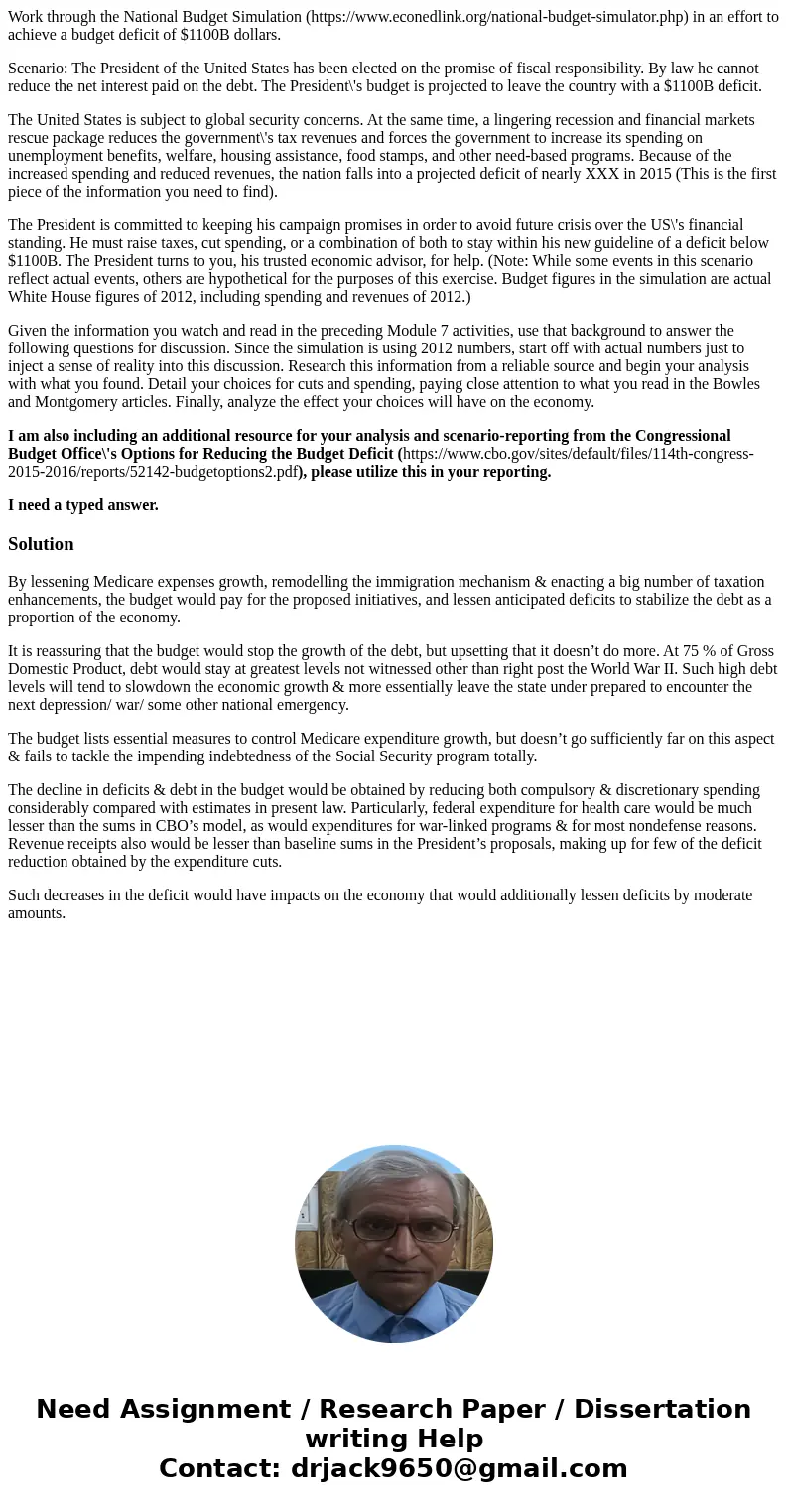Work through the National Budget Simulation httpswwweconedli
Work through the National Budget Simulation (https://www.econedlink.org/national-budget-simulator.php) in an effort to achieve a budget deficit of $1100B dollars.
Scenario: The President of the United States has been elected on the promise of fiscal responsibility. By law he cannot reduce the net interest paid on the debt. The President\'s budget is projected to leave the country with a $1100B deficit.
The United States is subject to global security concerns. At the same time, a lingering recession and financial markets rescue package reduces the government\'s tax revenues and forces the government to increase its spending on unemployment benefits, welfare, housing assistance, food stamps, and other need-based programs. Because of the increased spending and reduced revenues, the nation falls into a projected deficit of nearly XXX in 2015 (This is the first piece of the information you need to find).
The President is committed to keeping his campaign promises in order to avoid future crisis over the US\'s financial standing. He must raise taxes, cut spending, or a combination of both to stay within his new guideline of a deficit below $1100B. The President turns to you, his trusted economic advisor, for help. (Note: While some events in this scenario reflect actual events, others are hypothetical for the purposes of this exercise. Budget figures in the simulation are actual White House figures of 2012, including spending and revenues of 2012.)
Given the information you watch and read in the preceding Module 7 activities, use that background to answer the following questions for discussion. Since the simulation is using 2012 numbers, start off with actual numbers just to inject a sense of reality into this discussion. Research this information from a reliable source and begin your analysis with what you found. Detail your choices for cuts and spending, paying close attention to what you read in the Bowles and Montgomery articles. Finally, analyze the effect your choices will have on the economy.
I am also including an additional resource for your analysis and scenario-reporting from the Congressional Budget Office\'s Options for Reducing the Budget Deficit (https://www.cbo.gov/sites/default/files/114th-congress-2015-2016/reports/52142-budgetoptions2.pdf), please utilize this in your reporting.
I need a typed answer.
Solution
By lessening Medicare expenses growth, remodelling the immigration mechanism & enacting a big number of taxation enhancements, the budget would pay for the proposed initiatives, and lessen anticipated deficits to stabilize the debt as a proportion of the economy.
It is reassuring that the budget would stop the growth of the debt, but upsetting that it doesn’t do more. At 75 % of Gross Domestic Product, debt would stay at greatest levels not witnessed other than right post the World War II. Such high debt levels will tend to slowdown the economic growth & more essentially leave the state under prepared to encounter the next depression/ war/ some other national emergency.
The budget lists essential measures to control Medicare expenditure growth, but doesn’t go sufficiently far on this aspect & fails to tackle the impending indebtedness of the Social Security program totally.
The decline in deficits & debt in the budget would be obtained by reducing both compulsory & discretionary spending considerably compared with estimates in present law. Particularly, federal expenditure for health care would be much lesser than the sums in CBO’s model, as would expenditures for war-linked programs & for most nondefense reasons. Revenue receipts also would be lesser than baseline sums in the President’s proposals, making up for few of the deficit reduction obtained by the expenditure cuts.
Such decreases in the deficit would have impacts on the economy that would additionally lessen deficits by moderate amounts.

 Homework Sourse
Homework Sourse